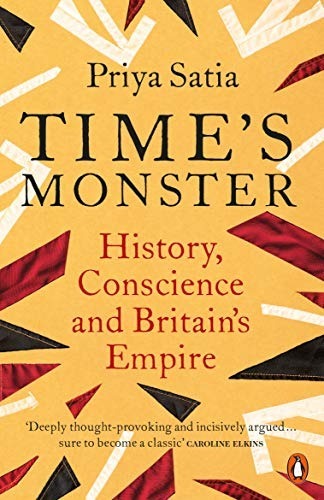
Time’s Monster: History, Conscience and Britain’s Empire (Allen Lane) by Priya Satia
Priya Satia begins Time’s Monster with a statement: historians, she says, are above all storytellers. At first glance this might not seem to be particularly controversial. History books are, after all, some of the biggest non-fiction best-sellers, with narratives that hold readers as spellbound as any novel. And as writers like Hilary Mantel have proven, the best historical novels can be as meaningful in crafting an image of the past as any scholarly tome.
But for many, the idea that history is merely a story might rankle. History, as an academic field, was constructed as a kind of science that sought to establish objective facts. As Satia sets out in her introduction, this professed goal to capture the truth of the past has made history the perfect subject for study among those with political ambitions. She cites Winston Churchill as an example. Having never actually studied history, he still went on to write several influential history books of events in which he himself had been a prominent figure. Hardly objective, they were still regarded in his day as authoritative texts.
Satia uses this sense of history as authority – not just in terms of its documenting of facts, but in its ability to provide “an ethical idiom for the modern period” – to examine the role that history and historians played in determining the course of British imperialism. She maintains that historians and historical arguments, from the Enlightenment onwards, not only controlled the way that the British viewed their imperial past, but also firmly delineated the possibilities for its future.
The conquest of India, for example, was justified in part through the use of historical narratives that emphasised Britain’s heroic purpose, and hence its right to commit the violent acts deemed necessary to fulfil its national destiny. Thinkers like Thomas Paine, who emphatically believed that “the past need not constrain the future” and that every generation “had the agency to make their own history”, were sidelined in favour of those who argued that history supported the imperial status quo. The popularity of Edward Gibbons’ The History of the Decline and Fall of the Roman Empire, published in the late 18th century against a backdrop of revolution in America and France, was rooted in a historical imagination that saw history as a story of progress, with Britain at the helm. As Satia notes, the six volumes came to be seen as a guide for the British Empire to avoid such pitfalls as beset the Romans before them.
A diverse range of anti-colonial thinkers – from Mahatma Gandhi to the historian E. P. Thompson – challenged these narratives of progress and destiny, prompting more imaginative thinking about possible futures. But imperial thinking still prevailed in the metropole. In fact, a key element of this attitude was the idea that the peoples being oppressed were inherently lacking in history themselves. The eminent historian Hugh Trevor-Roper in 1963 famously described the entirety of African history as simply the “unrewarding gyrations of barbarous tribes in picturesque but irrelevant parts of the globe”, which would therefore be pointless to study in an academic context.
Time’s Monster begins by accusing historians of long providing a cover story for the imperial establishment, but it ends by establishing the historian today as the new “critic of government”, and the field of history as embracing its task to “expose the scandal of empire”. This is undoubtedly true of some, but it is a leap to claim that all historians are now part of an anti-establishment order – traditionalists as well as radicals still stalk the archival stacks, as the author later acknowledges.
Satia finishes by worrying that the adoption of a more disruptive politics by some historians has proved to be a double-edged sword: once you are no longer telling a story that is useful to politicians, why would they continue to listen to what you have to say? But historians don’t only influence governments directly. As the book shows, campaigns like Rhodes Must Fall, and the call for reparations for slavery in Britain, America and the Caribbean, show how communities can take history from the pages and use it to push for change from the grassroots. As Satia says on the final page, “we need history to understand how we got here”. How we tell these stories of the past will continue to be a powerful political tool for people of all ideological stripes, whether we like it or not.
This piece is from the New Humanist summer 2022 edition. Subscribe here.

